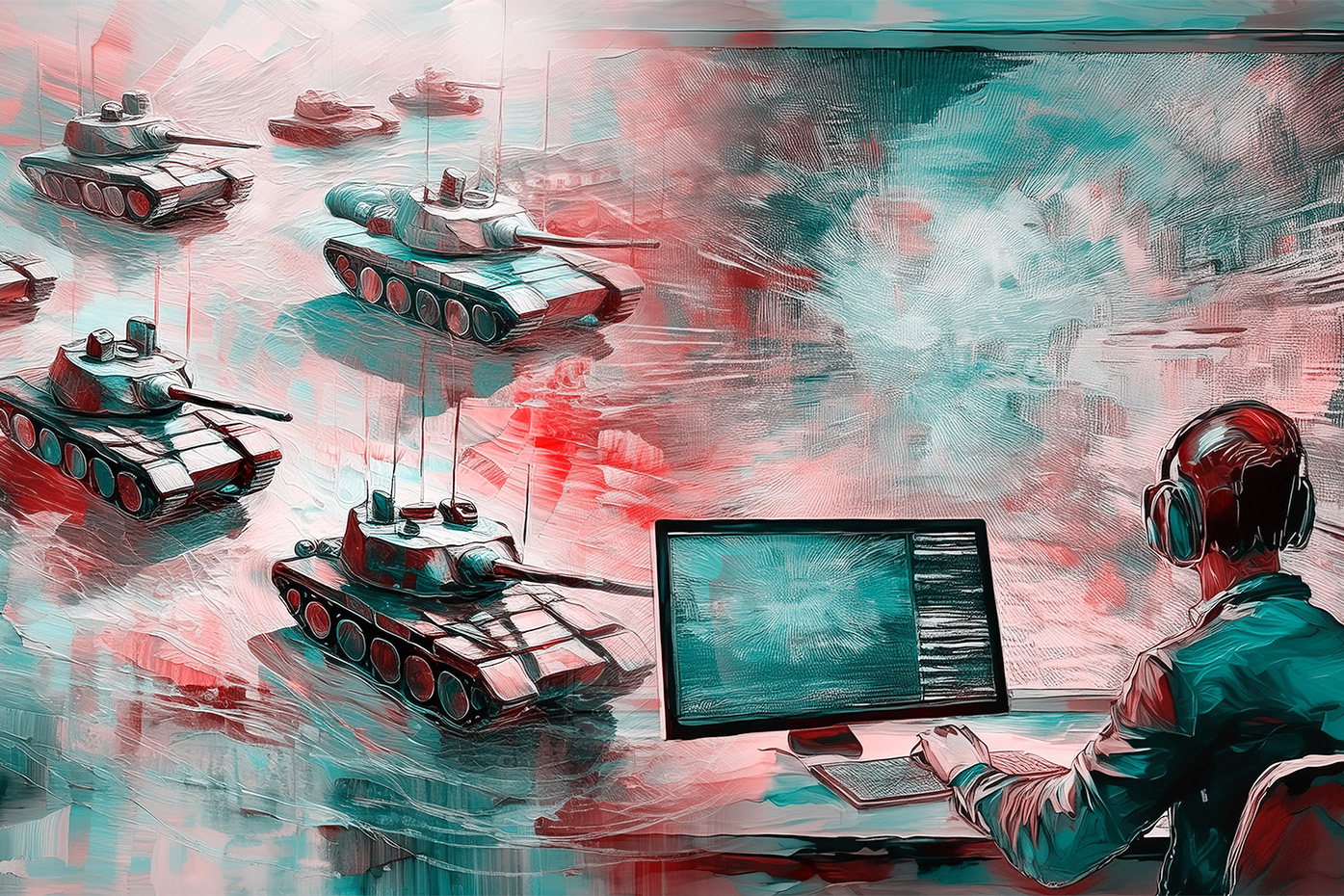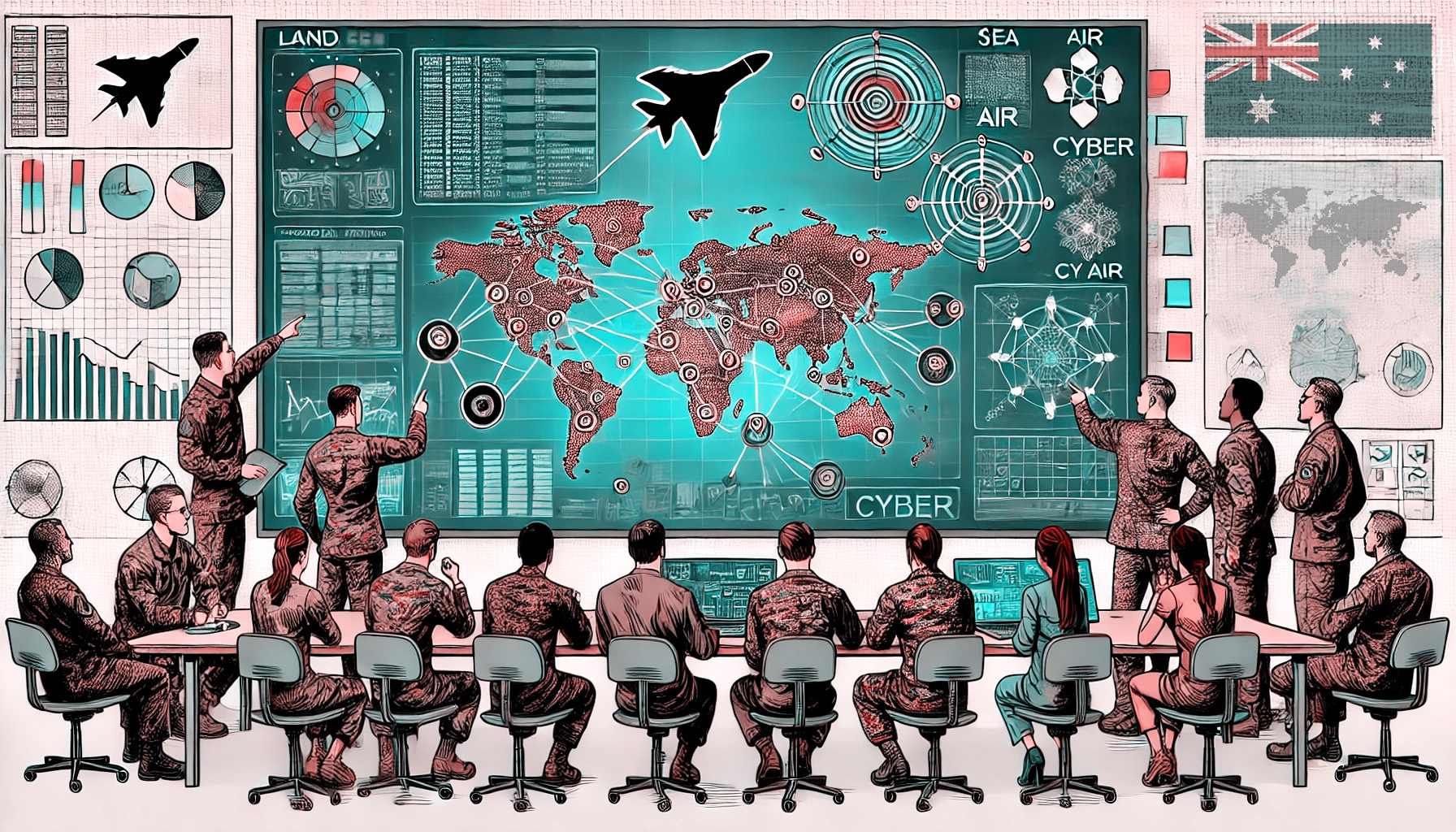In its current state, ADFP 5.0.1 does not mitigate the threat of ‘groupthink’ and must be updated to ensure that it remains a contemporary and applicable document for the Australian Defence Force. With countries such as the United States and the United Kingdom developing and using ‘red team’ doctrine, the ADF must develop and implement its own version. This essay will compare ADFP 5.0.1 against US and UK doctrine and argue that unless Australia introduces the ‘red team’ concept, ADF planners will continue to draft plans that lack creativity and do not exploit every possible opportunity.
By comparing Australia’s doctrine with US and UK doctrine, this essay will outline how using a red team can assist Joint Planning Teams, particularly as they move through three critical steps within the Joint Military Appreciation Process (JMAP). Only by introducing a red team concept into the next version of ADFP 5.0.1 can the ADF maintain a contemporary planning process that challenges planners as they seek to make assumptions, confirm facts, and draft courses of action for their commander to consider.
To support this thesis, this essay will first define the term ‘groupthink’ and outline how it can undermine a planning team’s ability to generate detailed and well-tested options for their commander. It will highlight which steps of the JMAP are most vulnerable to ‘groupthink,’ especially when a planning team may be fatigued, seeking to save time or under another form of pressure to finalise a particular output. Secondly, this essay will discuss the US and UK definitions of a red team and briefly outline how they can assist those tasked with conducting operational-level planning. It will include commentary on the benefits of leveraging an external team and emphasise how their contributions can minimise the ‘groupthink’ effect. Finally, this essay will highlight where red team guidance should be inserted into the JMAP and outline what support a red team should seek to offer. It will also propose mitigation measures for when ADF planners cannot leverage an independent red team and suggest how a planning team can maximise their objectivity to adequately test their assumptions, capabilities, and outputs. This will collectively emphasise the importance of the red team concept and highlight how its use would enable the ADF to mitigate the threat of ‘groupthink’ and regain its ability to test plans properly.
‘Groupthink’ and key ADFP 5.0.1 vulnerabilities
‘Groupthink’ is a significant challenge for military organisations due to their hierarchical structures and requirements for extreme conformity.[1] With a requirement to grow leaders internally, it can cause subordinates to mimic their superiors and not exploit true creativity as they seek to draft assumptions, confirm facts, and develop plans. Ahlstrom et al support this, offering that ‘groupthink’ is best defined as a ‘manner of thinking that people engage in when they are deeply involved in a cohesive in-group, and when the members’ strivings for agreement overrides their motivation to realistically appraise alternative courses of action’.[2] They also note that there are multiple parallels between how a military organisation functions or plans and the circumstances that can lead to groupthink.[3] Noting that organisations such as the ADF pride themselves on their ability to plan and achieve results quickly, this definition emphasises how alternate options can soon be discarded, particularly if one is favoured early by a Joint Planning Team. Though factors such as fatigue may encourage groupthink,[4] this essay focuses on the steps within ADFP 5.0.1 that are most susceptible to groupthink and the measures that can be introduced to mitigate it.
Within JMAP there are three steps that are more susceptible to the threat of groupthink. With steps one (Scoping and Framing), two (Mission Analysis), and four (Course of Action Analysis) requiring planners to make assumptions, confirm facts, and assess courses of action, it is more likely that groupthink will occur at one or more of these points. With step one requiring planners to identify and analyse the problem (sub-step one - framing),[5] the planning team must take a pragmatic approach and consider all available information. Unfortunately, due to an organisational predisposition to groupthink,[6] it is also possible for planners to become fixated on early suggestions, especially if offered by a senior planner or the commander.[7] Though the job of the planning team is to develop a robust and usable plan for their commander to issue, it is also imperative that they respectfully challenge them (when appropriate) to ensure that all relevant information is considered. With creativity being previously identified as a problem within hierarchal organisations,[8] if planners do not seek to understand the problem and communicate it effectively, it can negatively impact the subsequent steps of the planning process.
The second example exists within step two, specifically sub-step three, which requires the planning team to determine its mission.[9] Though this sub-step can be simplified if a higher commander dictates the mission, it still requires planners and their immediate commander to understand what has been directed. Noting that the threat and an environment can continually change, even if a mission is specifically issued to a subordinate planning team, the planners must confirm if it is still appropriate. If they believe that it is not right, they must engage the issuing authority and seek to understand if there are higher-level factors that caused their specific mission to be issued. On occasion, it is possible that the mission issued is no longer appropriate, and the issuing authority will provide an update. This interaction emphasises the importance of mitigating groupthink, with individuals within a hierarchical system often unwilling to question or raise doubts about the proposed plan.[10] Similar to step one, if the mission is not reviewed and confirmed, it can have significant ramifications as the planning team moves onto the course of action development and analysis steps.
The third vulnerability exists within the Course of Action Analysis (COA-A) step, precisely the wargaming aspect, where the planning team seeks to conduct a ‘meaningful analysis of each course of action’.[11] During this step, the J2 (intelligence) staff are generally required to act on behalf of the adversary,[12] a challenging task noting the requirement to remain objective. With groupthink already a significant problem for organisations such as the ADF, this is the third point in the JMAP where a planning team may be unable to correctly identify faults with their plan, especially if there is a bias towards one option over another. If those representing the adversary cannot remain objective, the planning team will not be able to thoroughly test each course of action, which may cause an incorrect recommendation to be made to their commander. Only through the use of a US- or UK-style red team will the ADF be able to encourage its planners to remain creative and objective as they seek to identify strengths and weaknesses in their plan.
Red teams and their applicability
Mitigating groupthink is difficult; however, by acknowledging human bias and seeking to encourage debate (where appropriate), it is possible to reduce its occurrence within an organisation.[13] By identifying three critical points within the JMAP where it is most likely to occur, the ADF can draw upon US and UK doctrine to understand how they have mitigated the problem. Noting that Australian, US, and UK joint planning doctrines are relatively comparable (naming of steps and general similarities between planning processes), it highlights how the absence of a red team concept within ADFP 5.0.1 is particularly unfortunate. With US and UK planning teams able to draw upon a red team, with its own guidance to challenge and support them, it emphasises how both countries have effectively sought to mitigate the threat of groupthink.
Within US doctrine, a ‘red team’ is defined as ‘an organisational element comprised of trained and educated members that provide an independent capability to fully explore alternatives in plans and operations in the context of the operational environment and from the perspective of adversaries, and others’.[14] Using a dedicated red team, the US outlines that its role is to ‘reduce risk, avoid surprise, see opportunities, increase operational flexibility, broaden analysis, and enhance decision making’.[15] Noting this definition and role, the US can ensure that planning teams are supported and that groupthink is mitigated wherever possible. By recognising that junior team members may not challenge the senior planner or commander (when appropriate),[16] the use of a red team can ensure that planning teams do not take unnecessary shortcuts or fixate on an assumption, fact or option. Additionally, by having a red team available to help those planning, they can inject alternate thoughts and challenge assumptions earlier than what would typically occur under the ADFP 5.0.1 construct. With ADFP 5.0.1 seemingly shaping ADF planners to formalise assumptions at fixed points, for example, the Mission Analysis back brief,[17] it is critical for alternate approaches such as those of the US and UK to be considered.
UK doctrine outlines that a red team’s role is to ‘identify and assess, among other things, assumptions, alternative options, vulnerabilities, limitations, and risks for that organisation’.[18] While similar to the US model, UK doctrine emphasises that the red team is not to take on the ‘red cell’ function, particularly during wargaming, as this remains the responsibility of the J2 (intelligence) Cell.[19] Within UK doctrine, it suggests that the red team’s role is to monitor and support the principal planning team,[20] an approach that also has the potential to address critical vulnerabilities or deficiencies early rather than wait for a formal back brief. With a red team being able to provide input during the Initiation (roughly equivalent to ADFP 5.0.1: Scoping and Framing) and Mission Analysis steps of the UK planning process, it highlights how a UK planning team is forced to challenge their assumptions and ideas continually. Additionally, though the J2 (intelligence) Cell is responsible for acting on behalf of the adversary during the Course of Action Analysis step, UK doctrine outlines how a ‘red team’ can provide additional feedback and guidance to the J2 (intelligence) Cell if required. This input may include an alternate assessment of the adversary’s capabilities or approach to a specific tactical or operational situation. Based on both US and UK doctrine, the use of red team doctrine, coupled with an independent team, can reduce the likelihood of groupthink, a view supported by civilian and military literature.
Noting that red team doctrine and the use of an independent team is proposed as a means to mitigate groupthink, it is also imperative that a small degree of separation remains between those planning and those tasked with supporting them. This will ensure that the red team does not become susceptible to groupthink itself and can continue to offer a unique and objective assessment. In addition to some separation, the red team must continually conduct its own planning and analysis as new assumptions, facts, and options become available.[21] By conducting independent planning and analysis, the red team can ensure that it maintains a high level of objectivity and creativity, thereby effectively supporting those in the planning team. Additionally, through separation, the red team can monitor its own fatigue and modify its planning process and contributions. If fatigued or small in size, the red team can seek to make their contributions less frequent but of higher quality. This negotiation will need to occur between key planners and the staff within the red team to be effective. By understanding each other’s requirements and limitations early, the red team can ensure that it supports the planning team in the best manner possible.
Implementing the ‘red team’ concept
Noting that during steps one (Scoping and Framing), two (Mission Analysis), and four (Course of Action Analysis), planners are most likely to succumb to groupthink, the ADF must encourage the use of a red team wherever possible at these points in the (JMAP). To achieve this, the ADF must first define the role of a red team early in ADFP 5.0.1, as it will enable planners to understand the role of the red team and suggest when they should be engaged. If limited in time, early explanation will also encourage senior planning team members to determine where they believe a red team contribution would be of most value and what they would like the red team to focus on. Early interaction is equally beneficial for the red team as it enables them to understand what pressures exist for the planning team and their key focus areas. Noting that US doctrine (Joint Publication 5-0) explains the role of a red team late in their planning document (Appendix J),[22] the ADF should consider taking the UK approach (Allied Joint Publication 5),[23] where they provide sufficient information upfront.
Within step one (Scoping and Framing), planners should seek contributions from the red team as they move through the framing sub-step. With a requirement to understand the environment and problem,[24] a red team can offer the planning team an alternative perspective and challenge them if they fixate on a particular problem narrative (the problem that must be overcome to achieve the desired transformation and end state[25]) too quickly. Additionally, the red team can add to the planning team’s list of assumptions or facts based on their analysis, ensuring that additional tensions, challenges, and opportunities are considered. As the planning team seeks to draft their problem narrative, the red team should also provide alternate perspectives, particularly as information requirements are developed for the commander to consider. By challenging each Friendly Force Information Requirement (FFIR), Essential Elements of Friendly Information (EEFI), and Priority Information Requirement (PIR) identified, the red team can force the planning team to consider the validity of their assessment and minimise duplication. It will also ensure that each information requirement can be quickly and effectively communicated to their commander and any subordinate planning teams.
Step two (Mission Analysis) offers a second opportunity for a red team to contribute, particularly as the planning team works through sub-steps two (Derive and Analyse Centres of Gravity) and three (Determine Own Mission). With two key sub-steps, the red team must seek to prioritise their support to those planning, especially if limited by time. With varying views on what constitutes a centre of gravity,[26] step two allows the red team to add value by ensuring that a senior or extrovert planning team member does not undermine the team’s ability to identify the most applicable option correctly. By conducting their own analysis, a red team can offer perspectives from non-military stakeholders and seek to challenge why a specific option should be prioritised. Sub-step three is equally important as it requires the planning team to draft or confirm its mission. Noting that the groupthink phenomenon can cause a planning team to uncritically accept an issued mission statement, the red team must assist by challenging the validity of what has been provided. By challenging the planning team to confirm why they should retain a specified mission, it will force them to review the threat and environment critically. If the planning team cannot justify why it remains relevant, it should trigger the senior member of the planning team to seek clarification from either their commander or superior headquarters.
Step four (Course of Action Analysis) is the third opportunity for a red team to contribute as the planning team seek to work through sub-step two (Conduct of the Wargame). With impartiality, credibility, and independence being three fundamental rules for the wargame,[27] the red team can ensure that adversarial capabilities are employed accurately and that each course of action is tested appropriately. Noting that the adversary is generally represented by the intelligence cell from within the planning team,[28] the red team can supervise each action and response. By monitoring each move within the wargame, the red team can then inject if they believe an action or response differs from what they would expect. By challenging the planning team to justify actions and outcomes as they progress through the wargame, it can ensure that all three rules are strictly followed and that an accurate result is obtained.
Noting that a red team is a valuable resource for any planning team to draw on, ADFP 5.0.1 must also outline what a planning team should do if a ‘red team’ is unavailable. If the environment and timeframe prevent a ‘red team’ from being available, ADDP 5.0.1 must outline what additional planning measures can be implemented to minimise the impact of ‘groupthink.’ While not ideal, a planning team can still partially achieve a ‘red team’ effect if they draw from the proposed ‘red team’ guidance within each step of the Joint Military Appreciation Process. Deliberately pausing between steps and reviewing the ‘red team’ notes can encourage a planning team to remain conscious of ‘groupthink’ and reflect on whether any agreement overrode their motivation to realistically appraise alternative courses of action.[29] By remaining conscious of the ‘groupthink’ problem and deliberately pausing between steps, the planning team can monitor itself and pause and recalibrate when required.
Conclusion
Unless a ‘red team’ concept is inserted into ADDP 5.0.1, the ADF will not have a contemporary planning process that enables it to effectively plan at the operational level. With ‘groupthink’ prevalent in hierarchical organisations such as the military, the ADF must ensure that steps one (Scoping and Framing), two (Mission Analysis), and four (Course of Action Analysis) within future iterations of ADDP 5.0.1 are drafted in a manner that supports planners. Noting that ‘groupthink’ is possible within a number of these steps, the ADF must encourage the use of independent ‘red teams’ to ensure that its Joint Planning Teams remain objective and able to provide options that have every strength and weakness identified.
With countries such as the US and UK already leveraging the ‘red team’ concept within their planning doctrine, the ADF must seek to understand the benefits associated with using such a tool and develop its own version. By inserting a ‘red team’ introduction at the beginning of ADDP 5.0.1 and step-specific guidance throughout the Joint Military Appreciation Process, the ADF can maximise creativity and objectivity. This will ensure that planners draft carefully considered options for their commander to consider and that bias has not prevented them from recommending the most appropriate option. Only by maintaining a robust and rigorous approach to planning can the ADF ensure that its subordinate personnel can exploit every opportunity to complete their mission and come home.
Ahlstrom, David, and Linda C. Wang. “Groupthink and France’s Defeat in the 1940 Campaign.” Journal of Management History 15, no. 2 (April 10, 2009): 159–77. https://doi.org/10.1108/17511340910943804.
Baron, Robert S. “So Right It’s Wrong: Groupthink and the Ubiquitous Nature of Polarized Group Decision Making.” In Advances in Experimental Social Psychology, 37:219–53. Elsevier, 2005.https://doi.org/10.1016/S0065-2601(05)37004-3.
Department of Defence. “ADFP 5.0.1 - Joint Military Appreciation Process - Ed2 AL3.” Directorate Publishing, Library and Information Services, August 15, 2019.
Department of Defense. “Joint Publication 5-0 - Joint Planning,” December 1, 2020.
Evans, Michael. “Centre of Gravity Analysis in Joint Military Planning and Design.” Security Challenges 8, no. 2 (Winter 2012): 81–106.
Kroon, Marceline B.R., Paul’t Hart, and Dik Van Kreveld. “Managing Group Decision Making Processes: Individual Versus Collective Accountability and Groupthink.” International Journal of Conflict Management 2, no. 2 (February 1, 1991): 91–115. https://doi.org/10.1108/eb022695.
Ministry of Defence. “Allied Joint Publication 5 - Allied Joint Doctrine for the Planning of Operations - Edition A Version 2, UK Change 1.” NATO Standardization Office, May 24, 2019.
Ministry of Defence. “Red Teaming Handbook, 3rd Edition,” June 2021.
Smith, Steve. “Groupthink and the Hostage Rescue Mission.” British Journal of Political Science 15, no. 1 (January 1985): 117–23.https://doi.org/10.1017/S0007123400004099.
University of Foreign Military and Cultural Studies. “US Red Teaming Handbook, Version 9.0.” Department of Defense, n.d.
Valine, Yousef A. “Why Cultures Fail: The Power and Risk of Groupthink.” Journal of Risk Management in Financial Institutions 11, no. 4 (2018): 301–7.
Vego, Milan. “On Military Creativity.” Joint Force Quarterly, no. 70 (2013): 83–90.
1 Milan Vego, “On Military Creativity,” Joint Force Quarterly, no. 70 (2013): 83–90., pp. 84-85
2 David Ahlstrom and Linda C. Wang, “Groupthink and France’s Defeat in the 1940 Campaign,” Journal of Management History 15, no. 2 (April 10, 2009): 159–77, p. 161
3 Ahlstrom and Wang. p. 161
4 Robert S. Baron, “So Right It’s Wrong: Groupthink and the Ubiquitous Nature of Polarized Group Decision Making,” in Advances in Experimental Social Psychology, vol. 37 (Elsevier, 2005), 219–253, p. 34
5 Department of Defence, “ADFP 5.0.1 - Joint Military Appreciation Process - Ed2 AL3” (Directorate Publishing, Library and Information Services, August 15, 2019)., p. 2-11
6 Steve Smith, “Groupthink and the Hostage Rescue Mission,” British Journal of Political Science 15, no. 1 (January 1985): 117–123, pp. 118-120
7 Ministry of Defence, “Red Teaming Handbook, 3rd Edition,” June 2021., pp. 17-18
8 Vego, “On Military Creativity.”, pp. 84-85
9 Department of Defence, “ADFP 5.0.1 - Joint Military Appreciation Process - Ed2 AL3.”, p. 3-18
10 Marceline B.R. Kroon, Paul’t Hart, and Dik Van Kreveld, “Managing Group Decision Making Processes: Individual Versus Collective Accountability and Groupthink,” International Journal of Conflict Management 2, no. 2 (February 1, 1991): 91–115, p. 96
11 Department of Defence, “ADFP 5.0.1 - Joint Military Appreciation Process - Ed2 AL3.”, p. 5-3
12 Department of Defence., p. 5-5
13 Yousef A Valine, “Why Cultures Fail: The Power and Risk of Groupthink,” Journal of Risk Management in Financial Institutions 11, no. 4 (2018): 301–307, p. 306
14 Department of Defense, “Joint Publication 5-0 - Joint Planning,” December 1, 2020., p. J-1
15 Department of Defense., p. J-1
16 University of Foreign Military and Cultural Studies, “US Red Teaming Handbook, Version 9.0” (Department of Defense, n.d.)., p. 53
17 Department of Defence, “ADFP 5.0.1 - Joint Military Appreciation Process - Ed2 AL3.”, p. 3-46
18 Ministry of Defence, “Allied Joint Publication 5 - Allied Joint Doctrine for the Planning of Operations - Edition A Version 2, UK Change 1” (NATO Standardization Office, May 24, 2019)., p. 3-18
19 Ministry of Defence., p. 3-18
20 Ministry of Defence., p. 3-18
21 University of Foreign Military and Cultural Studies, “US Red Teaming Handbook, Version 9.0.”, pp. 191-192
22 Department of Defense, “Joint Publication 5-0 - Joint Planning.”, p. J-1
23 Ministry of Defence, “Allied Joint Publication 5 - Allied Joint Doctrine for the Planning of Operations - Edition A Version 2, UK Change 1.”, p. 3-18
24 Department of Defence, “ADFP 5.0.1 - Joint Military Appreciation Process - Ed2 AL3.”, pp. 2-11 – 2-12
25 Department of Defence., p. 2-17
26 Michael Evans, “Centre of Gravity Analysis in Joint Military Planning and Design,” Security Challenges 8, no. 2 (Winter 2012): 81–106., p. 82
27 Department of Defence, “ADFP 5.0.1 - Joint Military Appreciation Process - Ed2 AL3.”, pp. 5-9 – 5-10
28 Ministry of Defence, “Allied Joint Publication 5 - Allied Joint Doctrine for the Planning of Operations - Edition A Version 2, UK Change 1.”, p. 3-18
29 Ahlstrom and Wang, “Groupthink and France’s Defeat in the 1940 Campaign.”, p. 3









Comments
Start the conversation by sharing your thoughts! Please login to comment. If you don't yet have an account registration is quick and easy.